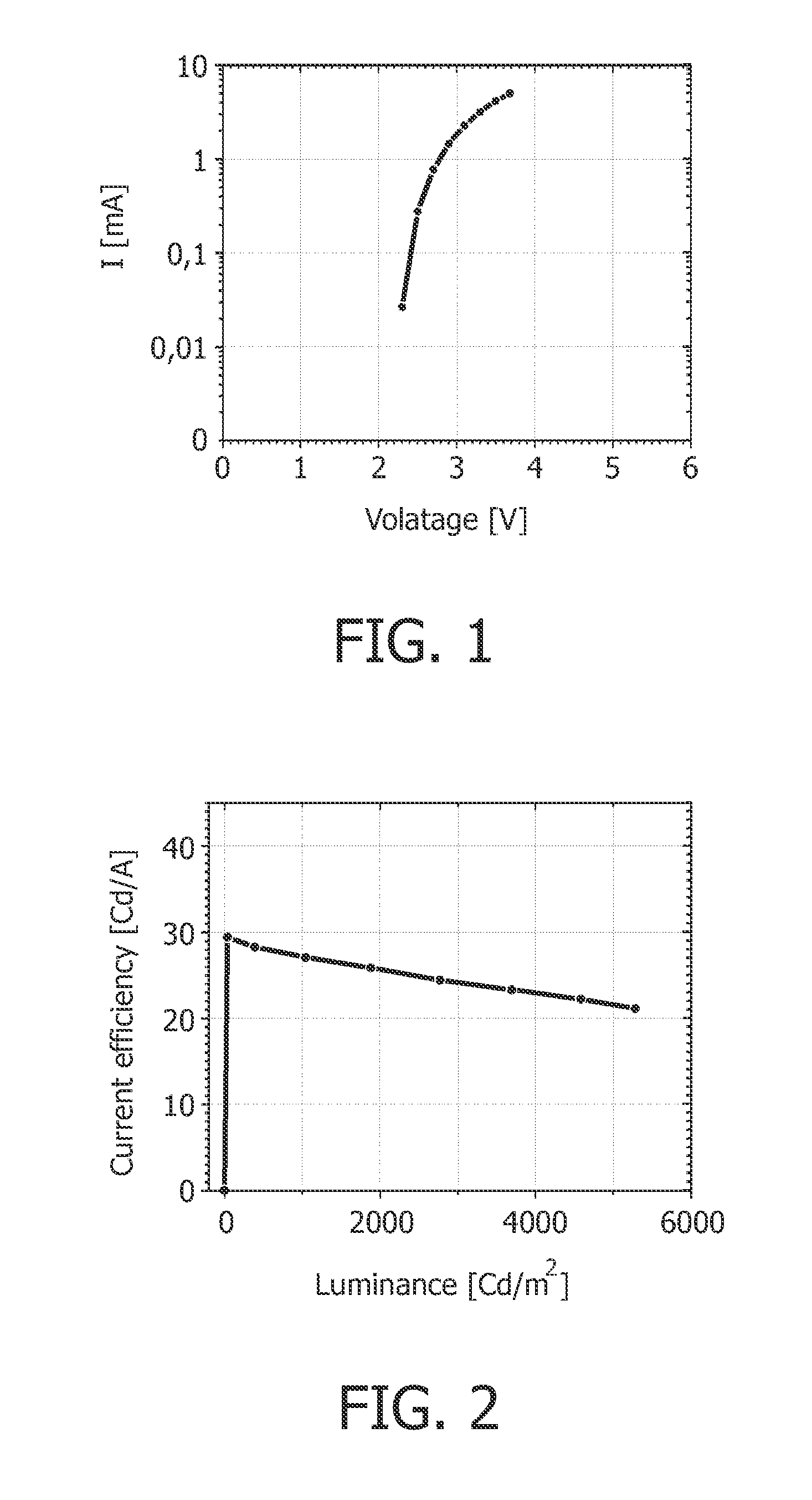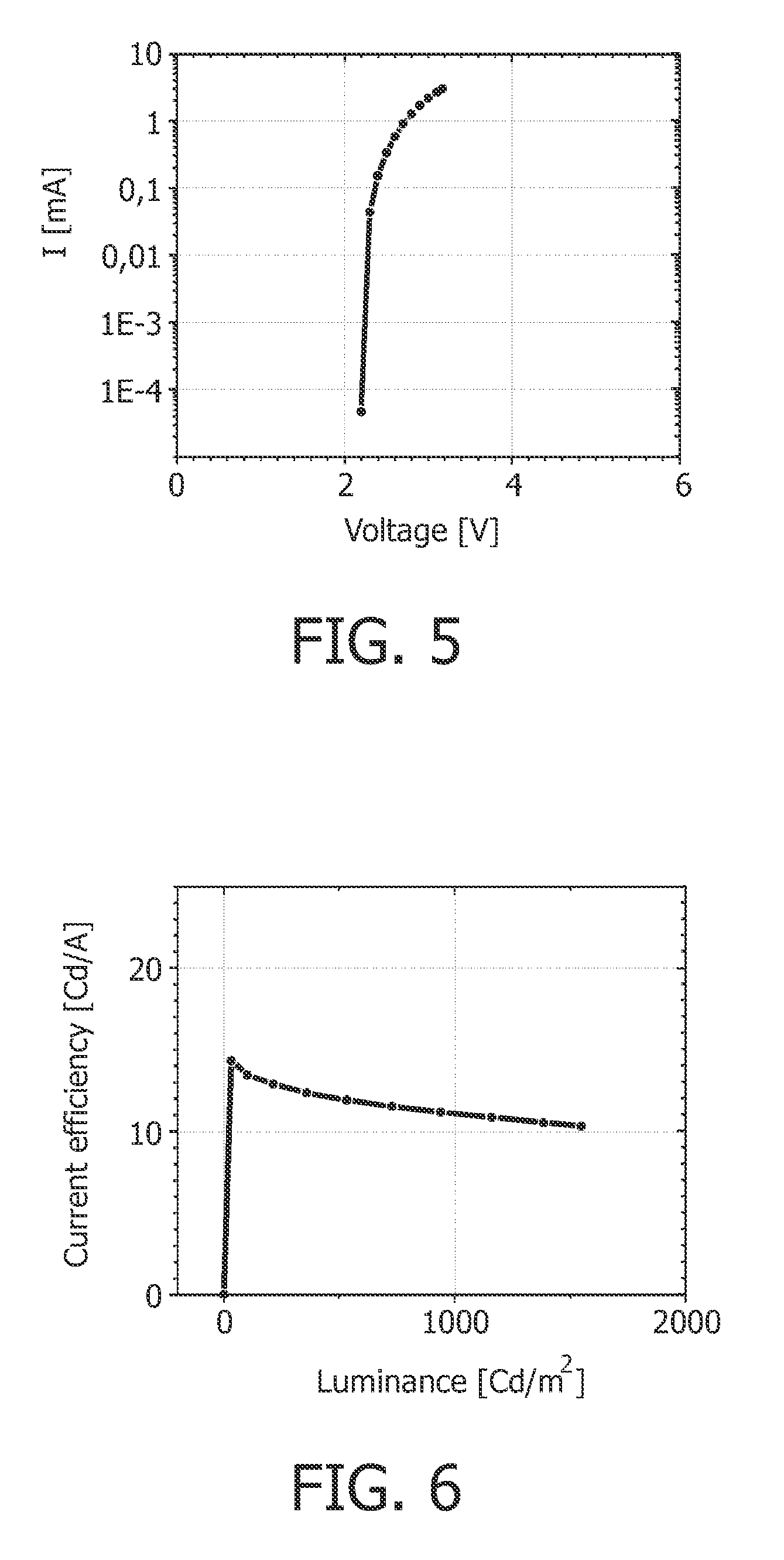OLED with metal complexes having a high quantum efficiency
a metal complex and quantum efficiency technology, applied in the direction of discharge tube luminescent screen, discharge tube/lamp details, luminescent compositions, etc., can solve the problems of general limited performance and some drawbacks in the field of luminescent deterioration, and achieve good color purity, increase the efficiency of the light-emitting layer, and suitable solubility and thermal stability
- Summary
- Abstract
- Description
- Claims
- Application Information
AI Technical Summary
Benefits of technology
Problems solved by technology
Method used
Image
Examples
example 1
[0086]Emitter Ir(2t-ppy) is doped into a matrix consisting of n-MTDATA. The detailed structure of the OLED device is shown in the table below. The triplet energy of Ir(2t-ppy) is 18600 cm−1.
TABLE 1Layer structure OLED device according to example 1.LayerMaterialthicknessAnodeITO120nmHole injection layerNHT1:NDP220nmHole transport layern-MTDATA10nmMatrix:Emittern-MTDATA:Ir(2t-25nmppy) 8 at %Electron transport layerTPBI10nmElectron injection layerNET5:NDN145nmCathodeAl100 nmITO = Indium tin oxide.n-MTDATA = 4,4′,4″-Tris(N-(1-naphthyl)-N-phenyl-amino)-triphenylamineTPBI = 1,3,5-tris-(1-phenyl-1H-benzimidazol-2-yl)-benzeneNHT1, NDP2, NET5, NDN1 are products of Novaled GmbH Dresden.NHT1:NDP2 is used to enhance inject of holes, andNET5:NDN1 is used to enhance injection ofelectrons into the OLED device.Formula 4: Structure of the emitter used in example 1.
[0087]The OLED device according to example 1 has at 1000 Cd / m2 a current efficiency of 27.2 Cd / A, and a power efficiency is 32.1 μm / W.
example 2
[0088]Emitter Ir(2t-tiaz) is doped into a matrix consisting of n-MTDATA. The detailed structure is shown in the table below. The triplet energy of Ir(2t-tiaz) is 17000 cm−1
TABLE 2OLED structure according to example 2.LayerMaterialthicknessAnodeITO120nmHole injection layerNHT1:NDP220nmHole transport layern-MTDATA10nmMatrix:Emittern-MTDATA:Ir(2t-25nmtiaz) 8 at %Electron transport layerTPBI10nmElectron injection layerNET5:NDN145nmCathodeAl100nmITO = Indium tin oxiden-MTDATA = 4,4′,4″-Tris(N-(1-naphthyl)-N-phenyl-amino)-triphenylamineTPBI = 1,3,5-tris-(1-phenyl-1H-benzimidazol-2-yl)-benzeneNHT1, NDP2, NET5, NDN1 are products of Novaled GmbH Dresden.NHT1:NDP2 is used to enhance inject of holes, andNET5:NDN1 is used to enhance injection ofelectrons into the OLED device.Formula 3: Structure of the emitter used in example 2.
[0089]The OLED device according to example 2 has at 1000 Cd / m2 a current efficiency of 11.1 Cd / A, and a power efficiency of 11.9 lm / W.
example 3
[0090]Production of an inventive triphenylene derivative of the formula (IIb) according to Scheme 3:
Synthesis of 2-Triphenylene carbonic acid
[0091]Step a)
[0092]Triphenylene (1 equivalent) is at 0° C. reacted with 2,1 equivalents AlCl3 and 21,0 equivalents CH3COCl in CH2Cl2. After 3 h stirring at room temperature the product (Acetyltriphenylene) is got in 97% yield, which is further reacted in Step b).
[0093]Step b)
[0094]The product of Step a) is reacted with mit 2,2 equivalents I2 (based on the raw yield of Acetyltriphenylene) in Pyridin solvent at room temperature. Then, the mixture is kept for 45 min under reflux, afterwards another portion I2 (1,0 equivalent) is added. After another hour at reflux NaOH, EtOH and water are added and the reaction mixture is heated to reflux for 2 h. 2-Triphenylene carbonic acid is got in 76% yield (based on the raw yield of Acetyltriphenylene and in 74% yield based on Triphenylene).
[0095]Production of a Triphenylene derivative according to formula I...
PUM
 Login to View More
Login to View More Abstract
Description
Claims
Application Information
 Login to View More
Login to View More - R&D
- Intellectual Property
- Life Sciences
- Materials
- Tech Scout
- Unparalleled Data Quality
- Higher Quality Content
- 60% Fewer Hallucinations
Browse by: Latest US Patents, China's latest patents, Technical Efficacy Thesaurus, Application Domain, Technology Topic, Popular Technical Reports.
© 2025 PatSnap. All rights reserved.Legal|Privacy policy|Modern Slavery Act Transparency Statement|Sitemap|About US| Contact US: help@patsnap.com



